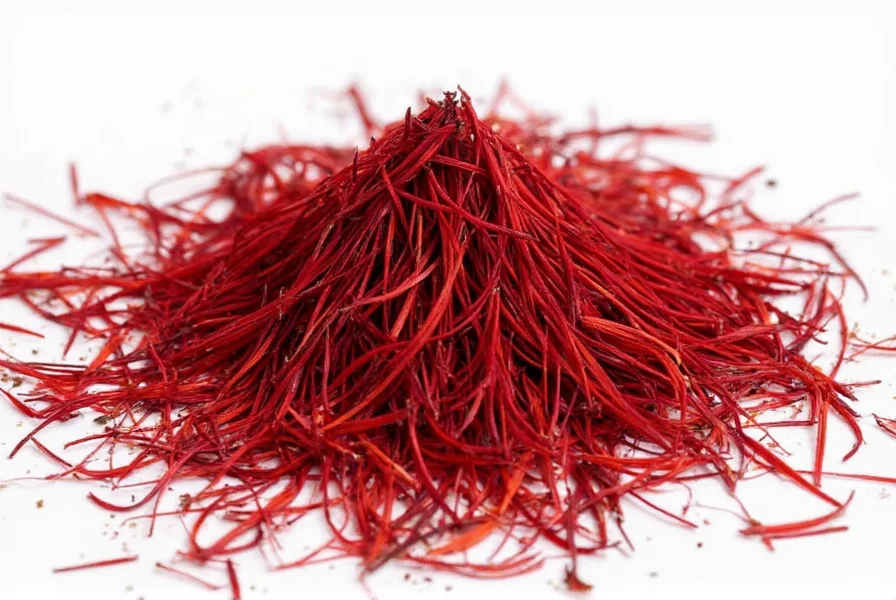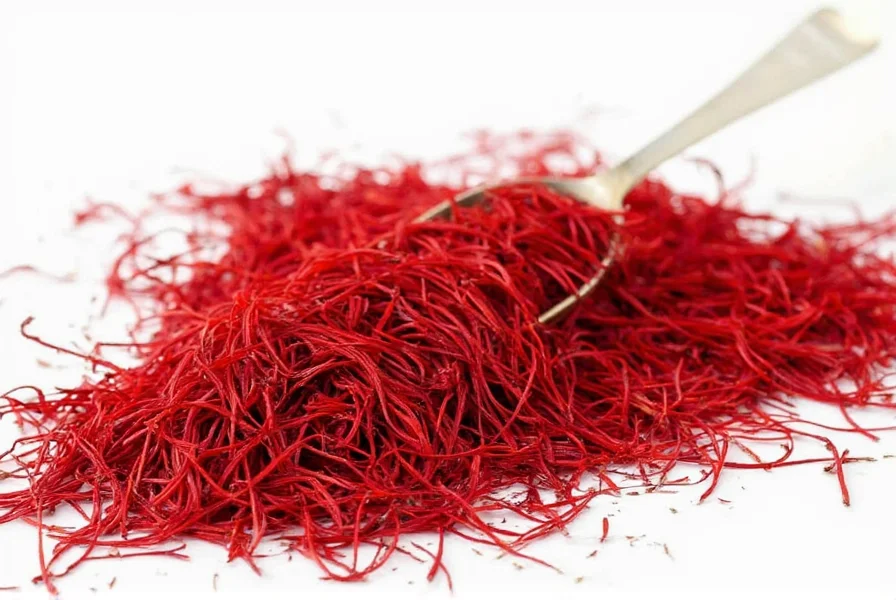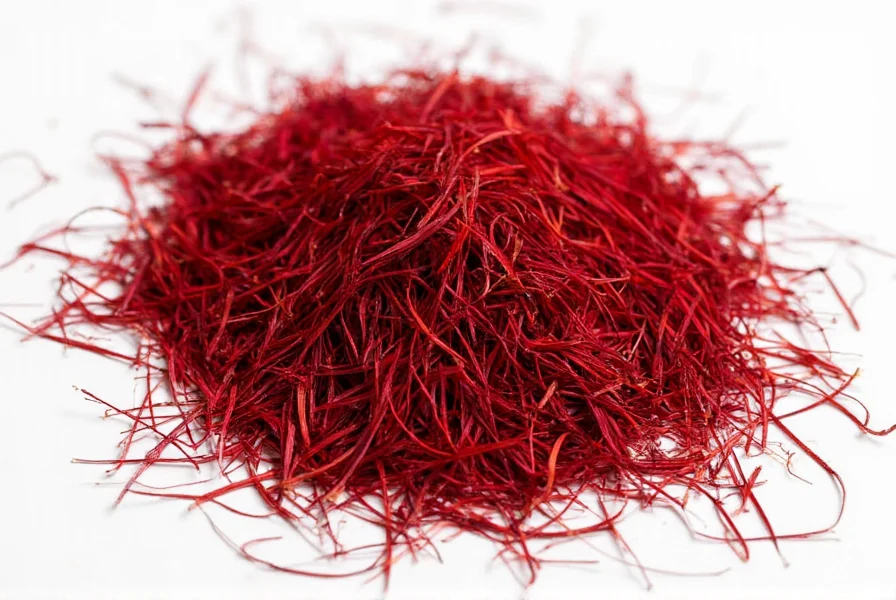When discussing Indian saffron, it's crucial to distinguish between authentic Kashmiri saffron and misleading products sometimes marketed as 'Indian saffron' that are actually turmeric or safflower. True Indian saffron comes exclusively from the Crocus sativus flower grown in the Kashmir region, where ideal climatic conditions and traditional harvesting methods produce saffron with exceptional quality characteristics.
What Makes Kashmiri Saffron Unique
Kashmiri saffron stands apart due to several distinctive features. The stigmas (threads) typically display a deep, rich crimson color with minimal yellow styles attached. This variety contains higher concentrations of crocin (the compound responsible for saffron's coloring strength) compared to many other saffron types, giving it superior coloring power in culinary applications.
The unique terroir of Kashmir's Pampore region, often called the 'Saffron Town of India,' contributes to its distinctive flavor profile. Kashmiri saffron offers a complex aroma with floral notes and a slightly sweet, honey-like flavor that lacks the bitter aftertaste found in some lower-quality saffron varieties.

Indian Saffron vs. Global Varieties
Understanding the differences between Kashmiri saffron and other major saffron varieties helps consumers make informed choices. The following comparison highlights key distinctions:
| Characteristic | Kashmiri Saffron | Persian/Iranian Saffron | Spanish Saffron |
|---|---|---|---|
| Coloring Strength (crocin) | Very High (240+) | High (190-240) | Moderate (150-190) |
| Aroma Intensity | Intense floral notes | Strong, earthy | Milder, more subtle |
| Thread Appearance | Deep crimson, minimal yellow | Bright red, some yellow | Reddish-orange |
| Price per Gram | Highest ($15-$30) | Moderate ($10-$20) | Lower ($5-$15) |
| Annual Production | ~15-20 metric tons | ~300+ metric tons | ~10 metric tons |
Culinary Applications of Authentic Indian Saffron
Kashmiri saffron's superior quality makes it particularly valuable in traditional Indian cuisine, especially in the elaborate dishes of Kashmiri wazwan (feast). The authentic Kashmiri saffron uses include:
- Rogan Josh - The iconic Kashmiri lamb curry where saffron provides both color and subtle flavor
- Yakhni - A delicate yogurt-based curry enhanced by saffron's floral notes
- Kahwa - Traditional Kashmiri green tea infused with saffron, almonds, and spices
- Biryani - Premium rice dishes where saffron creates beautiful color layering
- Shirmal - Saffron-flavored flatbread served with rich curries
Professional chefs recommend how to use Kashmiri saffron properly: Always soak threads in warm liquid (milk, water, or broth) for 15-30 minutes before adding to dishes. This releases maximum flavor and color. A little goes a long way - just 10-15 threads can flavor an entire dish for four people.

Identifying Genuine Indian Saffron
With why Indian saffron is expensive comes the unfortunate reality of widespread adulteration. Consumers should know these authentication methods:
Visual inspection: Genuine Kashmiri saffron threads are uniformly deep red with minimal yellow styles. Be wary of threads that appear orange or have excessive yellow portions.
The water test: Place a few threads in warm water. Authentic saffron will gradually release a golden-yellow color over 15-20 minutes, while fake saffron (often made from safflower or marigold) will discolor water immediately with an orange-red hue.
Aroma assessment: Crush a thread between your fingers. Real saffron emits a distinctive hay-like, floral fragrance. Artificial substitutes often smell medicinal or lack fragrance entirely.
Paper test: Place threads on blotting paper. Genuine saffron won't leave an immediate stain, while dyed imitations will.
Health Benefits and Traditional Medicine Uses
Traditional Ayurvedic medicine has utilized Kashmiri saffron benefits for centuries. Modern research supports several potential health applications:
- Mood enhancement: Studies suggest saffron may help alleviate mild to moderate depression
- Antioxidant properties: High crocin content provides significant free radical scavenging
- Eye health: May help protect against age-related macular degeneration
- Menstrual discomfort: Traditional use for reducing PMS symptoms
Researchers at the Indian Institute of Integrative Medicine have documented saffron's potential neuroprotective effects. However, consumers should understand that saffron health benefits in Indian tradition require proper dosage and shouldn't replace medical treatment for serious conditions.
Economic and Cultural Significance
Saffron cultivation represents more than just agriculture in Kashmir—it's a cultural heritage. The saffron cultivation in Kashmir tradition dates back over 2,500 years, with harvesting remaining largely manual. Each flower produces only three stigmas, and it takes approximately 150,000 flowers (450,000 hand-picked stigmas) to produce one kilogram of dried saffron.
This labor-intensive process explains why is Indian saffron expensive compared to other varieties. Climate challenges, including recent droughts affecting the Kashmir Valley, have further reduced yields, making genuine Kashmiri saffron increasingly rare and valuable.
Purchasing Authentic Indian Saffron
When seeking where to buy genuine Kashmiri saffron, look for these indicators of quality:
- Products labeled specifically as 'Kashmiri Mongra' or 'Kashmiri Lacha' saffron
- Certification from the Agricultural and Processed Food Products Export Development Authority (APEDA)
- Packaging showing the geographical indication (GI) tag for Kashmiri saffron
- Transparent pricing reflecting the premium quality (typically $15-$30 per gram)
Avoid products marketed as 'Indian saffron' that are suspiciously inexpensive, as these are likely turmeric or other substitutes. Reputable vendors will provide detailed information about harvest year, origin, and quality grading.
Frequently Asked Questions
Is Indian saffron the same as turmeric?
No, authentic Indian saffron refers specifically to saffron (Crocus sativus) grown in Kashmir, not turmeric. While some vendors misleadingly market turmeric as 'Indian saffron' due to its yellow color, they are completely different plants with distinct properties, flavors, and values.
Why is Kashmiri saffron considered superior?
Kashmiri saffron is prized for its exceptionally high crocin content (240+ on the ISO scale), giving it superior coloring strength. It also features a distinctive floral aroma and flavor profile with minimal bitterness. The unique growing conditions in Kashmir's Pampore region contribute to these premium qualities.
How can I verify if my Indian saffron is authentic?
Perform the water test: Place 3-4 threads in warm water. Genuine saffron will gradually release golden-yellow color over 15-20 minutes. Fake saffron (often dyed substitutes) will immediately turn the water orange-red. Also check for the distinctive hay-like aroma when crushing threads.
What makes Indian saffron so expensive?
Authentic Kashmiri saffron requires approximately 150,000 hand-picked flowers to produce one kilogram of dried saffron. The labor-intensive harvesting process, limited growing region in Kashmir, climate challenges affecting yields, and high demand for this premium variety all contribute to its high price ($15-$30 per gram).
How should I store Indian saffron to maintain quality?
Store saffron in an airtight container away from light, heat, and moisture. The ideal storage is a cool, dark place like a pantry or refrigerator. Properly stored, Kashmiri saffron maintains its flavor and aroma for 2-3 years. Never store saffron in the freezer as moisture can damage the delicate threads.











 浙公网安备
33010002000092号
浙公网安备
33010002000092号 浙B2-20120091-4
浙B2-20120091-4